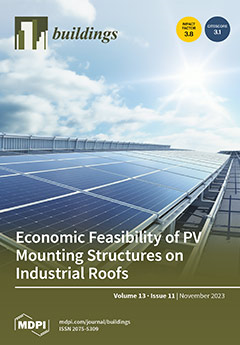Knowledge of indoor air quality (IAQ) in cob buildings during the first few months following their delivery is of vital importance in preventing occupants’ health problems. The present research focuses on evaluating IAQ in cob buildings through a prototype built in Normandy, France.
[...] Read more.
Knowledge of indoor air quality (IAQ) in cob buildings during the first few months following their delivery is of vital importance in preventing occupants’ health problems. The present research focuses on evaluating IAQ in cob buildings through a prototype built in Normandy, France. To achieve this, the prototype was equipped with a set of sensors to monitor various parameters that determine indoor and outdoor air quality. These parameters include relative humidity (RH), carbon dioxide (CO
2), nitrogen dioxide (NO
2), ozone (O
3), particulate matter (PM1 and PM10), and volatile organic compounds (VOCs). The obtained experimental results indicate that, overall, there is good indoor air quality in the prototype building. However, there are some noteworthy findings, including high indoor RH and occasional spikes in CO
2, PM1, PM10, and VOCs concentrations. The high RH is believed to be a result of the ongoing drying process of the cob walls, while the peaks in pollutants are likely to be attributed to human presence and the earthen floor deterioration. To ensure consistent good air quality, this study recommends the use of a properly sized Controlled Mechanical Ventilation system. Additionally, this study explored IAQ in the cob building from a numerical perspective. A Long Short-Term Memory (LSTM) model was developed and trained to predict pollutant concentrations inside the building. A validation test was conducted on the CO
2 concentration data collected on-site, and the results indicated that the LSTM model has accurately predicted the evolution of CO
2 concentration within the prototype building over an extended period.
Full article





